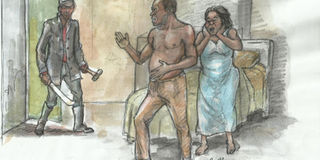Kiruhura murder investigations: The epitome of incompetence

The death of Daniel Karuhanga and five of his workers on the night of Friday, August 16, 2013 in Kiruhura District has been one of the high profile murders in the history of Uganda.
Shortly after the murders Joyce Kabashaho, the younger wife of the deceased was taken to Rwakitura to see President Museveni who assured her “Don’t fear, I am going to be your parent.” Karuhanga was killed in his bedroom in the presence of his younger wife and his niece, a school girl, who slept in the room adjacent to the bedroom.
Ordeal
During the night of the murders, the assailant also raped the school girl and stole the family car. Kabashaho did not sustain any injuries and neither did her son from another relationship and another relative.
Kabashaho saw her husband being killed. She told court that on the night in question she only saw one attacker and described him as a short black man who was dressed in black trousers, a black jacket and had put on black boots. She told court that she did not identify the killer as she had never seen him before.
She confessed that she could not identify the assailant again even if she saw him as the attack happened at night.
She, however, told court that the assailant had a machete, a hummer and what looked like a gun. She saw the hummer when the assailant hit her husband with it and saw the machete when the assailant used it to cut her husband. She saw the torch when the assailant switched it on to look under the bed to pick an army uniform from a suitcase. The army uniform apparently belonged to one of the sons of Karuhanga who was in the army.
The widow, under cross-examination told court that when the assailant entered their bedroom, there was solar light in the room that she used to identify the assailant. Her husband had switched on the light after the commotion outside when the assailant fought with one of the workers. The assailant switched off the light after hitting her husband. Two other people saw the assailant; the school girl who was raped and the 10 year old school boy who slept in the same room with some of the workers killed.
Schoolboy narrates
He told court that on the night of the murders he was woken up when he heard somebody opening the door to their room. The assailant told the boy to cover himself with a blanket. The boy said he did not see the face of the assailant but described him as “not short and not tall” and noted that he had put on a jacket. He also said he had never seen the assailant before. He under cross-examination admitted that it was dark in their room that night although he told court that the assailant carried a hammer, a machete, a stick and a torch. He also stated that one of the workers killed did not move from or in his bed when he was attacked.
School girl’s testimony
The school girl saw the assailant enter the house and the assailant spoke to her in Runyankore. She identified one of the accused persons, James Tumusime as the assailant.
In her own words she told court “He looks like the one I saw, I don’t know whether he is the one. She described the assailant as short and slender. When asked how she could see the features of the assailant at night, she replied that the assailant had a torch which he put on the bed while searching the suitcase which he had pulled from under the bed.
According to her testimony, the assailant had a long black jacket, a black trouser and gumboots. She further told court that the assailant had a torch and she was therefore able to see the assailant kill her grandfather. She also stated that Kabashaho gave the assailant some money that night.
She was not aware of the presence of the two other farm workers who were killed in the temporary structure they were sleeping in that night.
It was later in the morning that she knew they were dead when the police discovered their bodies. She had never seen them before; she only found them home when she came back from school. Under cross-examination it emerged that the school girl had been taken to various police stations in Kampala less than a month after the murders to identify the assailant but she failed to identify him during several identification parades. The murder of the six people that night and the subsequent investigations have raised a number of unanswered questions:
•It is clear from the evidence of the eye witnesses that there was only one assailant. How then did one assailant manage to kill six adult men using a machete in a very short span of time? And why did the men not defend themselves or put up any resistance?
•The assailant was very well versed with the intimate layout of the home and knew who slept where. Who provided him with this information? This must have been an attack which was planned over a period of time. Why did the investigators not track the phones of everybody in the homestead and to cover the period even before the attack?
•Why did the investigators fail to recover the stolen vehicle if indeed they arrested the real perpetrators of the offences?
Was this not in truth the epitome of incompetence of murder investigations in the country?
Next; the judgment




